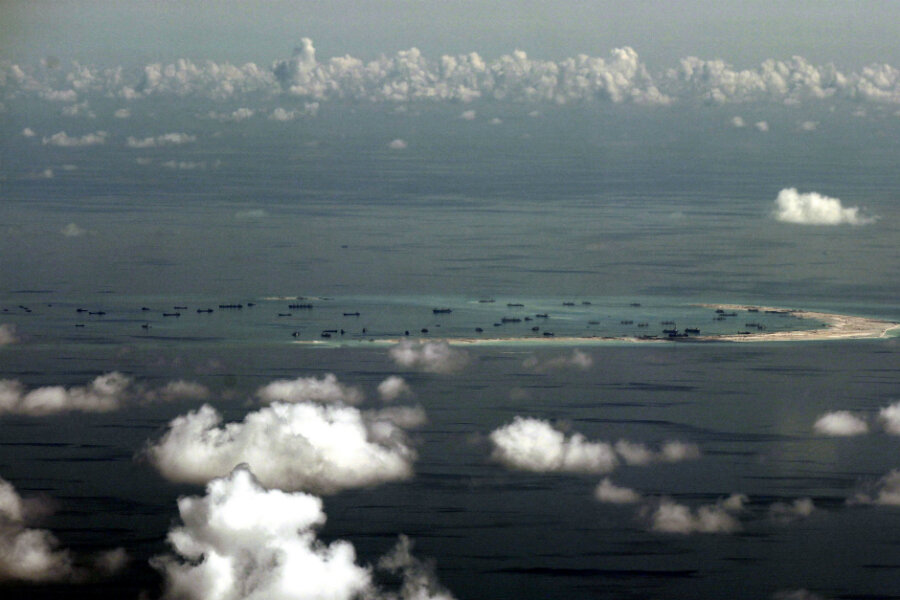US naval chief asserts navigation rights in contested South China Sea
A newly contentious phase appears to be under way in the South China Sea, where China has made expansive territorial claims, after the head of US naval operations said today in Tokyo that US vessels are free to travel “wherever international law allows."
Echoing earlier remarks by US Defense Secretary Ashton Carter, John Richardson, the US chief of naval operations, stated that, "It should not come as a surprise to anybody that we will exercise freedom of navigation wherever international law allows.” He added that "I don't see how this can be interpreted as provocative."
A Chinese spokesman responded by implying that islands China has recently constructed in the South China Sea are its territory, and that the US military should not violate Chinese sovereignty “in the name of freedom of navigation,” reports Reuters.
“China absolutely must not permit the U.S. side's warships and planes to behave unscrupulously near islands and reefs,” stated a comment in China’s Global Times newspaper, adding that such behavior would warrant a “counterattack.”
China claims a 12-mile exclusion zone around the islands that it has constructed in the South China Sea, which is a major transit route. By sending US vessels within this radius, the Pentagon would be rebutting this claim.
Australia, a US ally in the Pacific along with Japan, said today it would not join any US naval sorties in the area, though it has been conducting surveillance overflights, says Bloomberg. It adds:
Australia needs to walk a fine line with China, seeking to protect trade routes to its north without straining ties with its biggest trading partner, a large buyer of its iron ore and coal.
China has for nearly two years been dredging and pumping ocean sand to create land mass on South China Sea reefs and atolls that are large enough to build airstrips. The purpose of those instillations is thought to be military.
China claims huge swathes of ocean – 80 percent of the South China Sea – as its own territory. Its claim reaches nearly 1,000 miles below its own borders in what is know as the “nine dash line” or the “cow’s tongue,” which dips just off the coast of Indonesia and Brunei.
China experts regard Beijing’s claims over the territory as a historic and deeply felt bid for regional dominance that is emerging alongside China's rise in power, capability, and wealth.
After an increasingly aggressive “reclaimation” campaign last year that roiled seven regional nations, especially Vietnam and the Philippines, Beijing suddenly announced in late spring this year that it had stopped all building.
Yet just ahead of President Xi Jinping’s visit to Washington last month, it appeared that Chinese engineers were back, building new airstrips in at least two other places.
Bloomberg's editorial board this week counseled that island reclamation in and of itself is not illegal, and that nations like Vietnam have done the same in the past, though not at the scale and speed of China. Under maritime and international law, nations can’t claim territory that is underwater at high tide.
U.S. warships should chart their course carefully, targeting only islands such as Mischief Reef, which indisputably used to be underwater. Washington also has to make clear that the ships are conducting so-called freedom of navigation operations -- for instance, by engaging in surveillance during the journey or flying planes into the island's airspace. Otherwise the Chinese could simply claim the operation represented an "innocent passage" past its islands, something that is allowed within territorial waters.
The Associated Press today reports that China is holding two regional maritime forums in coming days in an effort to present its views as reasonable and its actions in the South China Sea as "for the public good." Chinese officials have argued that the reclamation projects have no military purpose.
But the AP notes also that China's military budget is growing rapidly.
With the world’s second-largest defense budget ... China’s military — especially its navy — is gathering formidable capabilities.
It will soon deploy its first aircraft carrier and is rapidly adding advanced destroyers, missile cruisers and nuclear submarines. A massive military parade in Beijing last month showcased new missiles permitting China to hit targets — including U.S. Navy ships and bases — throughout the region.





